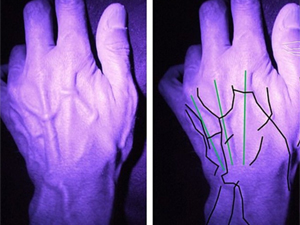



Date:15/02/19
 Scientists are working on a piece of technology that will catch criminals using pictures of their hands.
Scientists are working on a piece of technology that will catch criminals using pictures of their hands.
A combination of vein patterns, skin creases, scars, tattoos and pigmentation are used as key biometrics used to identify an individual.
These techniques have previously been used successfully in a court of law to identify child abusers from images of their hands.
The project will combine 'hard biometrics', such as fingerprints with 'soft biometrics' to obtain a comprehensive assessment of the person's true identity.
Professor Dame Sue Black, of Lancaster University, has pioneered the research.
She said: 'The hand retains and displays many anatomical differences due to our genetics, development, environment or even accidents so each person's hands are different.
'Now for the first time, researchers will analyse all the factors that make a hand truly unique so we can understand and use them reliably as evidence to identify individuals.'
The technology is a first of its kind and has never been attempted before, but anatomists, anthropologists, geneticists, bioinformaticians, image analysts and computer scientists are working together to create the system.
The researchers claim it opens up the opportunity to develop a variety of new biometric capabilities.
It would potentially have uses in security access, border control and assisting in the investigation of serious and organised crime on a global level.
More than 5,000 citizen scientists are now being recruited to create an open-source dataset for the programme.
The initiative has received €2.5million (£2.2million) in funding for the five year project which is being done by Lancaster University and the University of Dundee.
It is hoped the additional financing will enable the researchers to obtain more accurate imaging and identification in difficult lighting and positions.
Professor Dame Black said: 'A significant step change is required in the science to both reliably and repeatedly extract and compare anatomical information from large numbers of images especially when the hand is not in a standard position or when either the resolution or lighting in the image is not ideal.'
Criminals will soon be caught using just pictures of their hands
 Scientists are working on a piece of technology that will catch criminals using pictures of their hands.
Scientists are working on a piece of technology that will catch criminals using pictures of their hands.A combination of vein patterns, skin creases, scars, tattoos and pigmentation are used as key biometrics used to identify an individual.
These techniques have previously been used successfully in a court of law to identify child abusers from images of their hands.
The project will combine 'hard biometrics', such as fingerprints with 'soft biometrics' to obtain a comprehensive assessment of the person's true identity.
Professor Dame Sue Black, of Lancaster University, has pioneered the research.
She said: 'The hand retains and displays many anatomical differences due to our genetics, development, environment or even accidents so each person's hands are different.
'Now for the first time, researchers will analyse all the factors that make a hand truly unique so we can understand and use them reliably as evidence to identify individuals.'
The technology is a first of its kind and has never been attempted before, but anatomists, anthropologists, geneticists, bioinformaticians, image analysts and computer scientists are working together to create the system.
The researchers claim it opens up the opportunity to develop a variety of new biometric capabilities.
It would potentially have uses in security access, border control and assisting in the investigation of serious and organised crime on a global level.
More than 5,000 citizen scientists are now being recruited to create an open-source dataset for the programme.
The initiative has received €2.5million (£2.2million) in funding for the five year project which is being done by Lancaster University and the University of Dundee.
It is hoped the additional financing will enable the researchers to obtain more accurate imaging and identification in difficult lighting and positions.
Professor Dame Black said: 'A significant step change is required in the science to both reliably and repeatedly extract and compare anatomical information from large numbers of images especially when the hand is not in a standard position or when either the resolution or lighting in the image is not ideal.'
Views: 353
©ictnews.az. All rights reserved.Similar news
- Justin Timberlake takes stake in Facebook rival MySpace
- Wills and Kate to promote UK tech sector at Hollywood debate
- 35% of American Adults Own a Smartphone
- How does Azerbaijan use plastic cards?
- Imperial College London given £5.9m grant to research smart cities
- Search and Email Still the Most Popular Online Activities
- Nokia to ship Windows Phone in time for holiday sales
- Internet 'may be changing brains'
- Would-be iPhone buyers still face weeks-long waits
- Under pressure, China company scraps Steve Jobs doll
- Jobs was told anti-poaching idea "likely illegal"
- Angelic "Steve Jobs" loves Android in Taiwan TV ad
- Kinect for Windows gesture sensor launched by Microsoft
- Kindle-wielding Amazon dips toes into physical world
- Video game sales fall ahead of PlayStation Vita launch





















